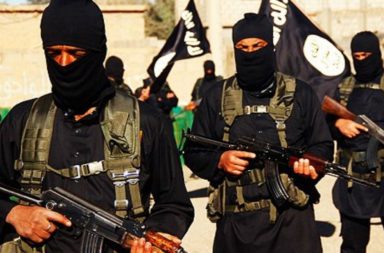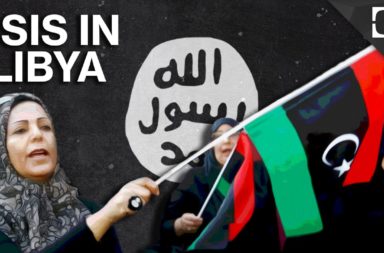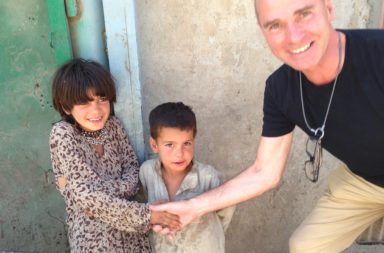Dabiq, the Islamic State’s mouthpiece, has released a tribute to the Paris attackers, together with pictures of each of them. This tribute uses pseudonyms for the attackers, instead of their real identities. It has made some startling revelations, including the claim that two of the suicide bombers who were earlier claimed to be Syrian refugees, had in fact forged their identity and passport to gain entry into the country. It also leaves out Salah Abdeslam, which we have explained previously.
First of all: they all will end in hell, not in heaven. Why ISIS is NOT Islam, you can read in details here.
The un-Islamic killers in Paris named are:
Ahmed al-Mohammed and M al-Mahmod
Presented by their specially designated names, militants ‘Ukasah al-Iraqi’ and ‘Ali al-Iraqi’ are believed to be Iraqi or have Iraqi origins. As the real names of the attackers are not released, these two militants closely resemble the pictures of ‘Ahmed al-Mohammed’ and ‘M al-Mahmod,’ which were identified in investigations as suicide bombers. Stade de France attacker Ahmed al-Mohammed or Ukasah al-Iraqi’s body was found with a Syrian passport, which led investigators to initially suspect he was a Syrian refugee. However, it was later found that this was a forgery.
Abdelhamid Abaaoud
Belgian militant Abdelhamid Abaaoud is believed to have visited the UK in August 2015, and to have shared information on social media that he succeeded in visiting Europe with the goal of organizing an IS(Daesh) terror cell. He subsequently managed to return back to Syria unharmed. Arriving through a Kent ferry port, Abaooud entered the country to meet British extremists in London and Birmingham. He even captured pictures of British landmarks on his mobile phone, but it has not yet been established whether Abaaoud was scheming to arrange terror attacks in Britain through this. His photograph collection includes a snapshot of Birmingham’s Bull Ring shopping centre. Abaooud also allegedly led a jihadi network recruiting militants for the Islamic State group in Syria. According to reports, Abaaoud narrowly escaped capture by Greek authorities in January 2015, who discovered that Abaooud was running a Belgian terror cell from Athens.
After his trip to the UK, Abaaoud led the attacks on a sports stadium, concert venue and restaurants in Paris in November 2015. He was eventually killed during a police raid of an apartment in the Saint-Denis area of the French capital, days after the attack. He was killed alongside Chakib Akrouh.
Chakib Akrouh
On 18th November 2015, as the French police raided a Saint-Denis apartment after the Paris attacks, Chakib Akrouh detonated a vest, killing himself, his aide Abaaoud and Abaaoud’s female cousin, French national Hasna Aitboulahcen. As claimed by Paris prosecutor Francois Molins, Akrouh’s identity was established by using DNA samples from his mother. Akrouh was a 25-year-old Belgian-Moroccan, living in the Brussels suburb of Molenbeek. The local authorities were well-versed with his fundamentalist outlook. In fact, in July 2015 Akrouh was convicted in absentia by a Brussels court, which sentenced him to five years behind bars in a trial against a jihadi network recruiting militants for the Islamic State (Isis) group in Syria. This is the same network that Abaaoud was believed to be part of. However, it was believed that Akrouh was based out of Syria, travelling to Europe at least twice since 2013 – eventually executing the deadly Paris attacks in November 2015.
Salah and Brahim Abdeslam
Brothers Salah and Brahim Abdeslam, 26 and 31, ran a café named Les Beguines in the Belgian suburb of Molenbeek. This café was shut down by authorities earlier in November 2015 because it was believed to be a drug-dealing hub. Later, the duo took part in the savage Paris attacks. Salah travelled to Budapest in Hungary to pick up militants who had arrived with a massive influx of refugees. Brahim detonated a suicide vest near a café on Boulevard Voltaire in Paris on 13 November 2015, blowing himself up. Salah is believed to have driven the militants to their targets in a hired car. An abandoned vehicle containing Salah’s fingerprints was found near the Bataclan theatre, where the concert attendees were killed. An abandoned explosive belt was found amid a pile of rubbish in the southern Paris district of Montrouge, which the authorities suspect could have belonged to Salah, who possibly backed out from the plot last minute. Salah then fled the country, being driven by accomplice Hamza Attou, together with Mohammed Amri. It has since been discovered that Salah contacted the alleged accomplices after the attack, and threatened to blow up the car if they didn’t drive him back to Belgium. Their car was believed to have been stopped by French authorities three times on their way back to Belgium, but since Salah had not yet been declared a suspect, he was manage to escape unnoticed. He is still at large, and is one of Europe’s most wanted terrorists. Salah is still alive, which is probably why he is left out from Dabiq’s pictorial tribute, which seems to feature only those militants who were slain.
Bilal Hadfi
20-year-old Bilal Hadfi was a French citizen, who was living is Belgium. On the day of the attack, he attempted to enter Stade de France where France was playing against Germany. Having been denied entry into the stadium, he blew himself up near rue de la Cokerie. Hadfi lived in Neder-over-Hembeek in Belgium, and Belgian prosecutors claim they knew he went to Syria to fight with IS, but were unaware about how he arranged his return.
Omar Ismail Mostefai
Mostefai was a 29-year-old French national of Algerian descent. He blew himself up after the massacre at Bataclan, where 89 people were killed. He was born in the Paris suburb of Courcouronnes, where the police identified him as a petty criminal. He garnered eight convictions between 2004 and 2010, but did not spend any time in jail. He lived in Chartres near Paris from 2005 to 2012. French authorities identified Mostefai as a suspected Islamic radical in 2010, and entered his details in a database. Since then it is believed he could have travelled to Syria and Algeria. After the Paris attacks,Turkish authorities received an information request about Omar Ismail Mostefai from France, as records showed that he entered Turkey in 2013 but there were no records to prove he had left.
Samy Amimour
28-year-old Amimour was also a suicide bomber who blew himself up at the Bataclan. In 2012, it was claimed that he planned to go to Yemen, which resulted in him being charged with terror offences. He was placed under judicial supervision but couldn’t be tracked after some time, which led authorities to issue an international arrest warrant. French newspaper Le Monde published in 2014, the details of a journey by a 67-year-old Parisian man travelled to Syria to request his son to leave IS and return to France. After the son refused to leave, the father had to return home without him. This son is now believed to be Amimour, as the true identity of both father and son were hidden by pseudonyms.




